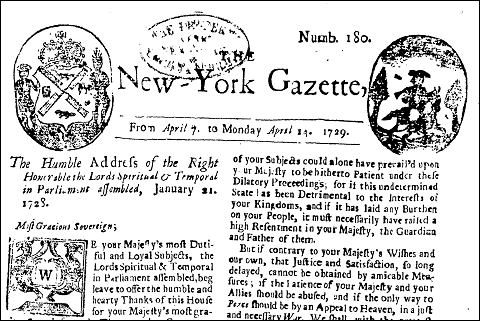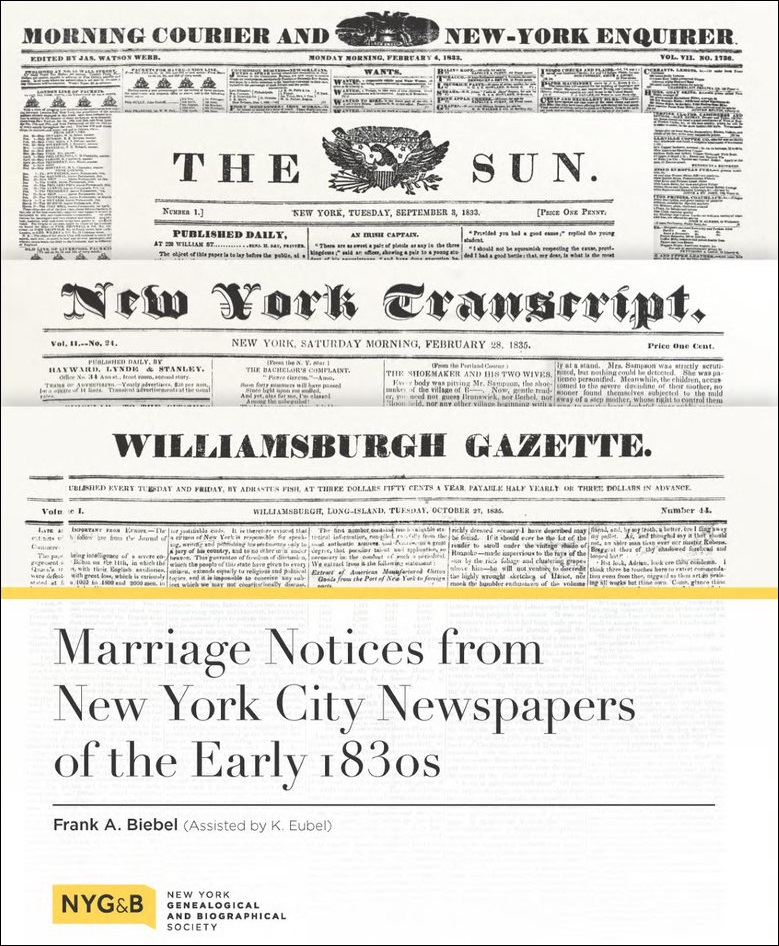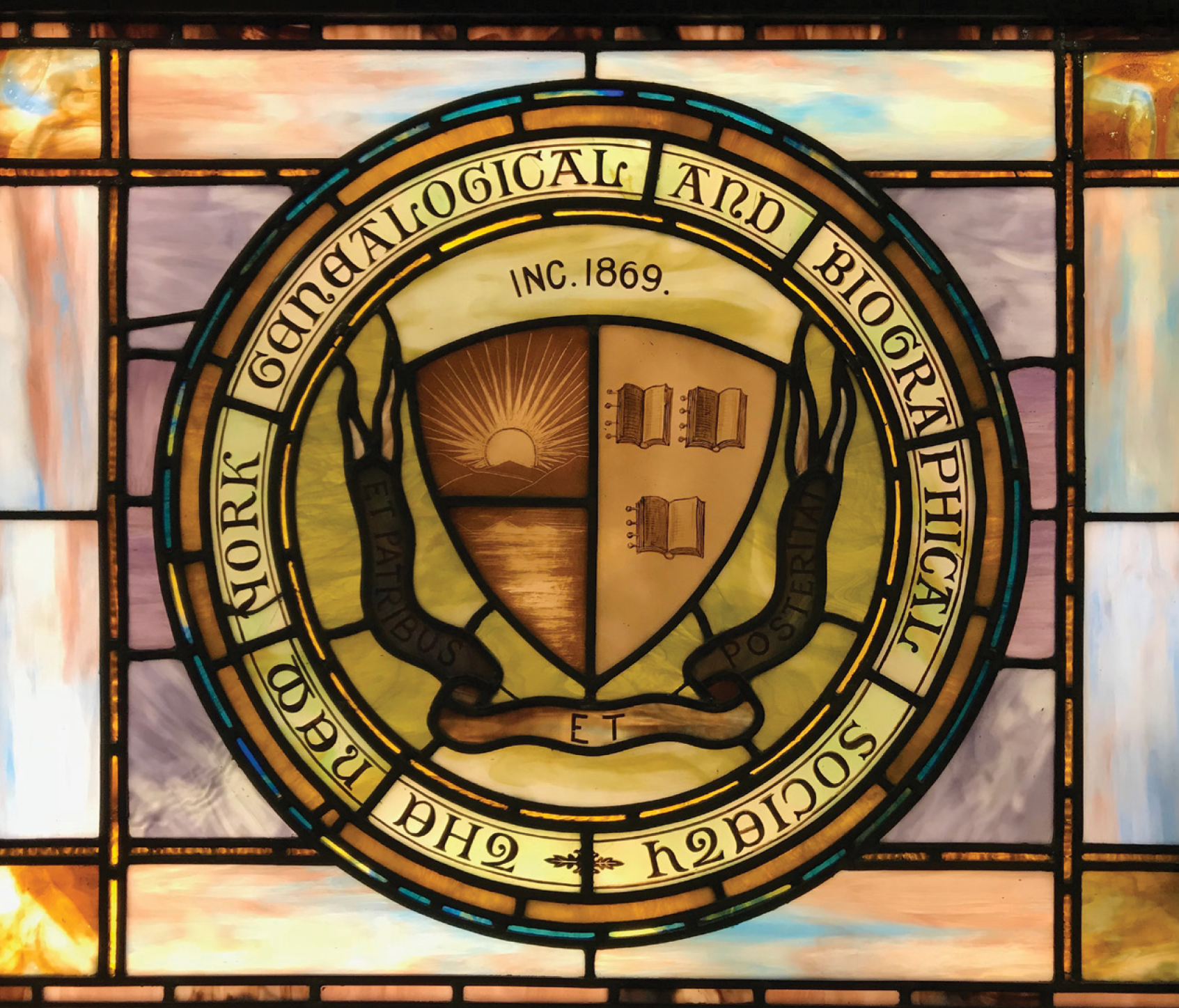This blog is authored by NYG&B Summer Intern Kyle Brinster. For more information about interning at the NYG&B see our internships page.
Newspapers can be quite a boon to genealogists. Freed from the rigid constraints of vital records and bureaucratic forms, they include not just notable events in an ancestor's life but can give researchers greater insight into the community at large.
As stated in the New York Family History Research Guide and Gazetteer, “in addition to birth, marriage, and death notices, newspapers include biographical material (occasionally with surprising detail), descriptions of social functions, school announcements, missing relatives, and even scandals, gossip, and crime that most families work hard to suppress.” Researchers can find more information on this topic in our blog article, Why historical newspapers are crucial genealogy sources.
Like all historical records, newspapers have evolved over time - before using newspapers for family history research, it is important to understand what kind of information newspapers typically contained at any given moment in history.
This article will provide a general overview of the history of newspaper publication with a focus on New York, providing crucial and useful context for the researcher.
Pre- and Post-Revolutionary America: 1725 - 1800
The first newspaper in New York was the New-York Gazette, published by William Bradford beginning in 1725.

Gazette newspapers published during this time period were
very different than those of later decades.
Image via Wikimedia Commons
It was a simple operation; Historian Frank Luther Mott describes a "small two-page paper, poorly printed, and containing chiefly foreign news from three to six months old, state papers, lists of ships entered and cleared, and a few advertisements."
Early colonial newspapers largely rehashed information from older London papers, the target audience being the relatively limited merchant class whose business dealings made this information vital.
This changed in 1783 when the Philadelphia Evening Post became the country’s first daily newspaper, a switch made to keep the bustling port city up to date with the latest shipping news. The end of the Revolutionary War also coincided with a surge of politically partisan papers - most notably Alexander Hamilton’s Federalist leaning New York Evening Post, launched in 1801, which survives to this day as the New York Post.
While newspapers from this period are crucial historical sources, they are unlikely to contain the type of information genealogical researchers can expect from newspapers published more recently.
The Rise of the Penny Press: 1800 - 1844

several notable "penny press" papers.
By the mid-nineteenth century, cheaper paper and better printing techniques led to an explosion of new newspapers, which mirrored New York’s population boom. Between 1810 and 1870 the state’s population grew by over 400% and according to the New York Family History Research Guide and Gazetteer, over 600 different papers were published across the state by 1855.
These came in a variety of styles but the most important for genealogical researchers were the so-called “penny press” (or penny papers), originated by the New York Sun in 1833. The four-page morning paper was especially popular with New York City’s working class, and it grabbed the title of largest circulating American newspaper the year after it’s premiere.
The paper was filled with local news and help wanted ads, but the most popular articles were the “sensational and sometimes fabricated stories and the paper’s exaggerated coverage of sundry scandals,” according to the Library of Congress' Chronicling America project. The Sun also introduced a nineteenth-century New York staple - armies of newsboys or newsies who peddled the paper each day.
Penny papers contain more useful information for the family history researcher than other papers that had been published up to that point in history. For example, the NYG&B has recently published a volume of abstracts created by Frank A. Biebel - Marriage Notices from New York City Newspapers of the Early 1830s. This volume is available to search in the NYG&B eLibrary, and can also be purchased as a print publication.
News off the Wire: 1844 - 1865
The invention of the telegraph had a profound impact on the way newspapers operated. Now information could be relayed across great distances in practically no time at all. However, this new technology was as expensive as it was revolutionary.
In 1848, six of the largest New York newspapers (the New York Journal of Commerce, the New York Herald, the New-York Tribune, the Morning Courier, New-York Enquirer, the New York Morning Express, and The Sun) banded together to defray these costs in their effort to cover the Mexican War, forming the Associated Press.
Telegraphs even altered the way papers were written. They popularized the terse, clipped language and reliance on headlines to relate the most important facts upfront, in case there were communications issues.
Do not forget to immerse yourself in the historical world of your relatives. Their stories often come alive through reading local advertisements and articles about local events in historical newspapers. An article does not have to mention your ancestor by name to offer a glimpse into their past.
- NYG&B President D. Joshua Taylor
End of Expansion: 1890s
Newspapers were carried with people as they trekked westward across the United States. This didn’t happen in a smooth wave; papers popped up in boomtowns like San Francisco before less populated areas across the Midwest.
In the 1890s the country crossed a major threshold: there became no unsettled territory in the continental U.S. This coincided with an explosion in the nation’s immigrant population through centers like Ellis Island in New York Harbor, which opened its doors in 1892.
Immigrant newspapers became big business, printed in at least 18 languages including almost 100 German-language daily papers.
Into the Twentieth Century
The early years of the twentieth century were dominated by the fierce rivalry between newspaper titans William Randolph Hearst and Joseph Pulitzer. Their attempts to outdo each other led to the era of “yellow journalism” - sensational stories with little to no evidence.
In the 1920s and 1930s, newspapers saw a dramatic pullback, as commercial radio and the Great Depression dealt publishers a one-two punch. This led to consolidation by larger companies, allowing publishers to collect all of a city’s newspapers under their umbrella.
By the 1950s the country’s entire cultural landscape was changing. Many people left cities for the suburbs, and as a result smaller, local newspapers flourished - by 1960 there would be over 2,000 suburban papers nationwide.
These local papers are often some of the best newspapers for genealogical research - many were started well before the mid-twentieth century. Below is just one example of the amazing family history information that can be found in a local historical newspaper:

surprising amount of personal news.
New Paltz Times., 19 June 1889
via NYS Historical Newspapers
The Modern Newspaper: 1970s - Today
The biggest innovation in publishing in the 1970s was the rise of alternative press outlets like the Village Voice. These catered to students increasingly alarmed by U.S. action in Vietnam.
Throughout the 1980s and 1990s, TV and internet news options contributed to the decline of local reporting as the country’s largest papers like the New York Times and the Washington Post pushed to increase their circulation nationwide. This is still seen today, with a few large media conglomerates dominating the industry.
Takeaways
Newspapers have been a staple of American culture since its inception. While the larger national papers may have the greatest resources and best editorial staff, it is the smaller local and regional papers that are an excellent resource for genealogists.
This isn’t simply because of marriage announcements and obituaries; community events, real estate news, and general goings-on are equally important to gain information about how an ancestor may have lived.
This last bit may be the most important. As NYG&B President Joshua Taylor reminds us, “an article does not have to mention your ancestor by name to offer a glimpse into their past.”
More Newspapers and Genealogy
-
Why historical newspapers are crucial genealogy sources
-
Guide to Online Historical New York Newspapers
-
Find your ancestor's obituary: New York Times and other sources
Newspapers in the NYG&B eLibrary
-
Marriage Announcements in New York City newspapers (1833-1836)
-
Information Wanted Ads in the Truth Teller (Irish Newspaper), New York City (1825-1844)
-
Index to Marriage and Death Notices in the New-Yorker Staats-Zeitung (German Newspaper) (1836–1870)
-
New York Times Obituaries Index, 1858 - 1968
-
Marriage & Death Abstracts, Queens (1847-1870)
About the New York Genealogical and Biographical Society

a registered 501(c)(3) organization devoted to
preserving, documenting, and sharing the history of
New York State families. Read more about our mission.
Since 1869, our mission has been to help our thousands of worldwide members discover their family's New York story, and there has never been a better time to join.
The cost of an Individual Annual Membership is less than six dollars a month, and includes the following benefits:
- Access to over 50 exclusive digital record sets covering the entire state of New York, including the fully searchable archives of The Record.
- A complimentary subscription to all of Findmypast's North American records, as well as U.K. and Irish Census records.
- Access to hundreds of expert-authored Knowledge Base articles and webinars to help you navigate the tricky New York research landscape.
- Exclusive discounts and advanced access to conferences, seminars, workshops and lectures to learn more about researching people and places across New York State.
To learn more or join us, please visit our member benefits page.
